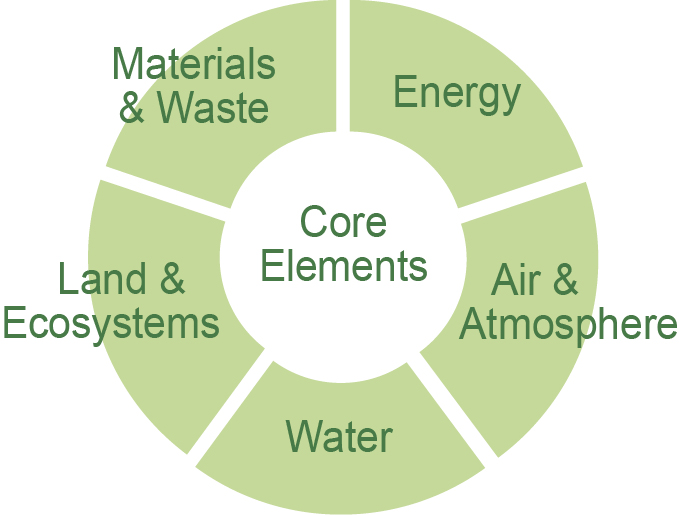Green Remediation Focus
Overview
In the News
- Integrating green remediation and climate resilience work in Superfund service contracts
- EPA releases fact sheet about considering climate change at contaminated groundwater sites
- Enhanced tool now available to find products or services covered by an ecolabel or standard
- Using EPA's Water Sensors Toolbox to understand capabilities and limitations of water sensors
- Climate adaptation measures taken at the Wyckoff Co./Eagle Harbor NPL site along Puget Sound
- EPA releases fact sheet about BMPs for PCB sites » News archives...
Upcoming Events

Learn about the core elements for green remediation strategies that inform cleanups in each of these areas by clicking on them.
- May 20-23, 2024 | The American Solar Energy Society's annual conference, Solar 2024: Connecting Technology & Policy
- June 2-6, 2024 | Battelle's 4-day Chlorinated Conference » More on the calendar...
State-of-the-art technologies, novel field methods, and "tried and true" design and engineering techniques can be combined to address the core elements of green remediation. Best management practices are in place under a range of cleanup programs including Superfund, RCRA, federal facility, brownfield, and state voluntary actions. Explore details about the site-specific profiles available below.
Executive Order 14072: Strengthening the Nation's Forests, Communities, and Local Economies
This April 22, 2022, E.O. sets forth federal policy to deploy climate-smart forestry and other nature-based solutions to improve resilience of lands, waters, wildlife and communities in the face of disturbances and stress arising from climate impacts. The solutions include actions that protect coasts and critical marine ecosystems, reduce flooding, moderate extreme heat, replenish groundwater sources, capture and store carbon dioxide, and conserve biodiversity. Cleanup at Port Hadlock's Site 10 North End Landfill illustrates how such solutions can be planned and implemented at Superfund sites in coastal settings.
Executive Order 14057: Catalyzing Clean Energy Industries and Jobs Through Federal Sustainability
This December 8, 2021, E.O. sets forth federal policy to lead by example in order to achieve a carbon pollution-free electricity sector by 2035 and net-zero emissions economy-wide by no later than 2050.
Executive Order 14008: Tackling the Climate Crisis at Home and Abroad
This January 27, 2021, E.O. sets forth policy and initiatives to advance our transition to clean energy and reduction in greenhouse gas emissions. Use of greener cleanup strategies in the U.S. EPA's Superfund and other site cleanup programs helps meet the policy goals by integrating renewable energy, deploying clean fuel and emission technologies, protecting water, sequestering carbon, conserving land, protecting critical ecosystems and biodiversity, and using nature-based solutions.
- Greener Cleanups Best Management Practices: PCB Cleanups
 (8pp, 760K) *New*
(8pp, 760K) *New* - Excavation and Surface Restoration
 (5pp, 286K)
(5pp, 286K) - Site Investigation and Environmental Monitoring
 (4pp, 179K)
(4pp, 179K) - Pump and Treat Systems
 (6pp, 673K)
(6pp, 673K) - Bioremediation
 (4pp, 493K)
(4pp, 493K) - Soil Vapor Extraction & Other Air-Driven Systems
 (4pp, 457K)
(4pp, 457K) - Clean Fuel & Emission Technologies for Site Cleanup
 (10pp, 354K)
(10pp, 354K) - Integrating Renewable Energy
 (6 pp, 840K)
(6 pp, 840K) - Sites with Leaking Underground Storage Tanks
 (4pp, 216K)
(4pp, 216K) - Waste Cover Systems and Integrated Site Reuse Planning
 (5 pp, 641K)
(5 pp, 641K) - Mining Sites
 (6pp, 535K)
(6pp, 535K) - Implementing In Situ Thermal Technologies
 (6pp, 249K)
(6pp, 249K) - Materials and Waste Management
 (4pp, 397K)
(4pp, 397K)
Learn about footprint assessment tools and view comprehensive reports on footprint evaluations conducted at sites undergoing cleanup. EPA's universal greener cleanup metrics provide a uniform and transparent approach to quantifying the environmental footprint associated with materials, wastes, water or energy that are used or generated during a cleanup. EPA's Spreadsheets for Environmental Footprint Analysis (SEFA) tool is available to help evaluate the environmental footprint of a cleanup project at a detailed level.
Resources
GR Technology Primer![]() (56pp, 814K)
(56pp, 814K)
Incorporating Sustainable Environmental Practices into Remediation of Contaminated Sites.
Community Guide to Greener Cleanups![]() (2pp, 1.4MB)
(2pp, 1.4MB)
Incorporating Sustainable Environmental Practices into Remediation of Contaminated Sites.

